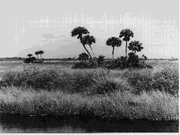Everglades Province (Bailey)
Southern Florida, Florida Keys, 7800 mi2 (20,200 km2)
Land-surface form
The Everglades occupy an extensive, almost flat marl and limestone shelf generally covered with a few feet of muck and a little sand. Elevation ranges from sea level to 25 feet (7.6 meters). The low, level coastal plain contains large areas of swamps and marshes, with low beach ridges and dunes rising several feet above them. Poorly defined broad streams, canals, and ditches drain into the Atlantic Ocean and Gulf of Mexico. In the interior, hammocks rise a few feet above the general area.
Climate
Average annual temperatures in this subtropical climate range from 70 to 75°F (21 to 24°C), with minima occurring from October to February. The area is frost-free practically all year. An average of 50 to 65 in (1,280 to 1,660 mm) of rain falls per year, mostly between late spring and the middle of autumn.
Vegetation
About one-fifth of the area is covered by subtropical moist hardwood forest. Cypress forests are most extensive, but mangrove is widespread along the eastern and southern coasts. Much of the area is open marsh covered by phreatophytic grasses, reeds, sedges, and other aquatic herbaceous plants. Several areas covered by dense grasses are classified as medium-tall grasslands, with sawgrass and three-awns as major plants. Within these grasslands there are mesic habitats called "hammocks" that rise above the surrounding, usually wetter areas. These hammocks contain groves of low to medium-tall broadleaf evergreen trees and shrubs. Mahogany, redbay, and several palmettos are common. One also finds strangler fig and abundant epiphytes.
Soils
Histosols are the principal soils. In slightly less wet parts of the southern Everglades, Inceptisols occupy extensive areas.
Fauna
The Everglades have a wide variety of influent species from adjacent areas of palmetto prairie, cypress swamp, magnolia forest, and mangrove. Slight changes in water level create substantial changes in habitat and fauna.
Among the many mammals found are whitetail deer, Florida panther, black bear, raccoon, bobcat, opossum, skunk, various bats, marsh and swamp rabbits, cotton rat, and fox squirrel. Manatees inhabit estuaries and interlacing channels.
Numerous species of birds live in this province. Before the water level in much of the Everglades was lowered by drainage, the area was home to large numbers of herons, egrets, limpkins, mottled ducks, Florida Everglade kites (snail kites), and other birds. The Florida Everglade kite is now classified as endangered.
Characteristic lizards are the Caroline anole and the brown red-tailed skink. The rough green snake, key rat snake, and southern Florida coral snake are found here. The endangered American alligator is a year-round resident.
Return to Ecoregions of the United States
| Disclaimer: This article contains information that was originally published by the United States Forest Service. Topic editors and authors for the Encyclopedia of Earth have edited its content and added new information. The use of information from the United States Forest Service should not be construed as support for or endorsement by that organization for any new information added by EoE personnel, or for any editing of the original content. |
